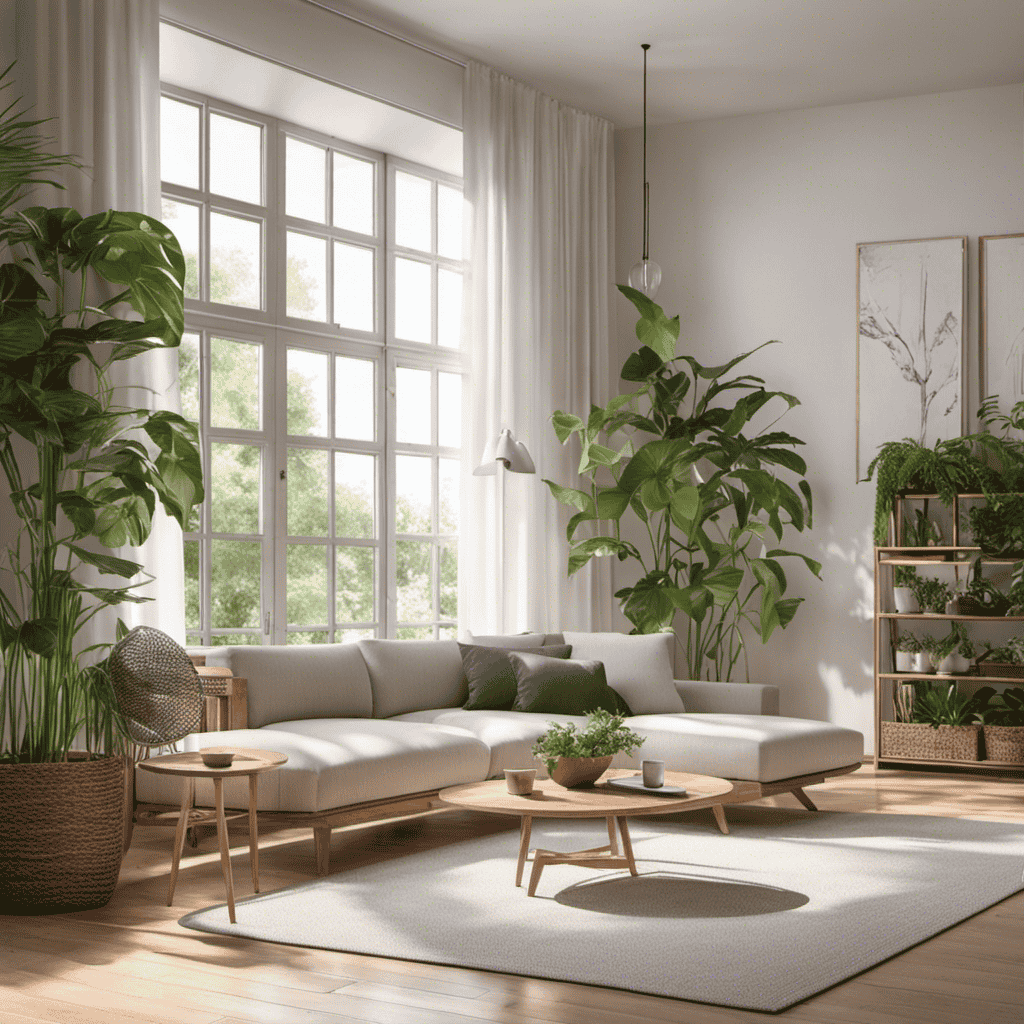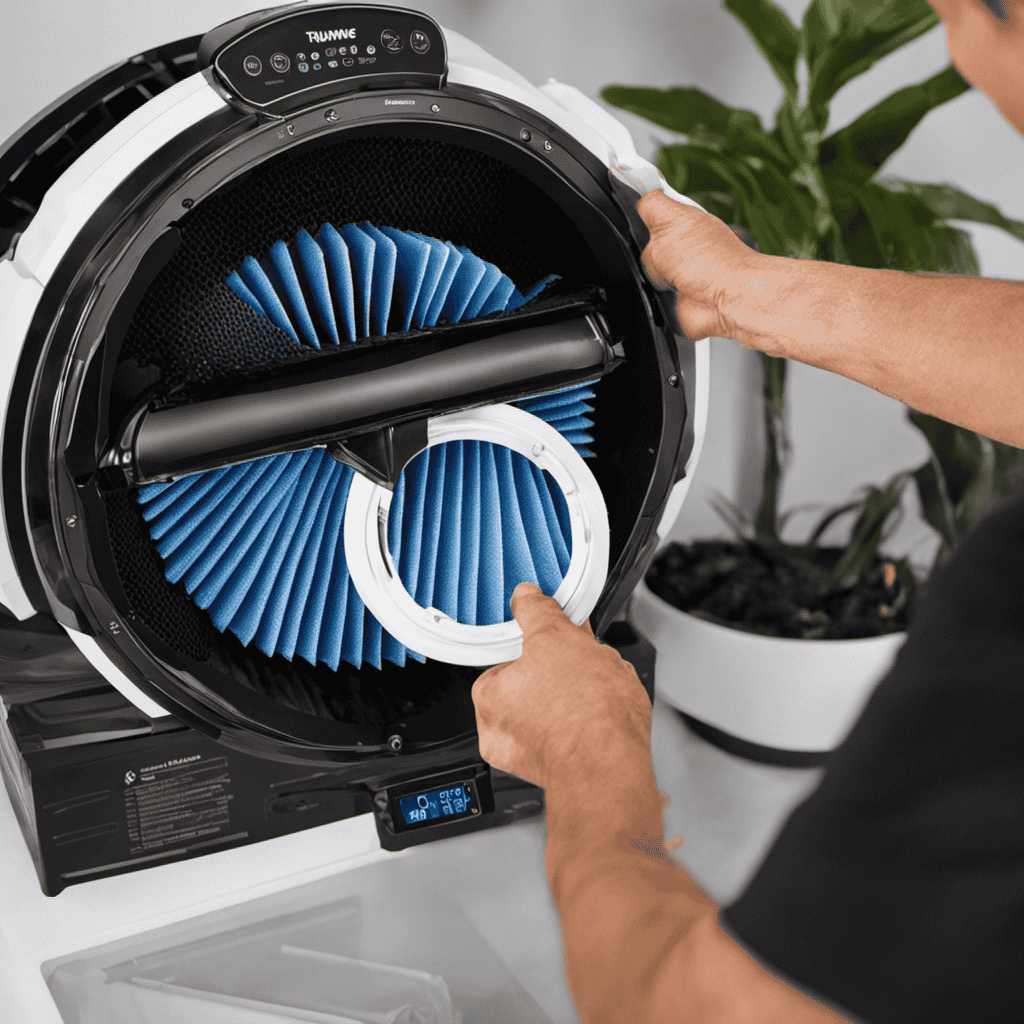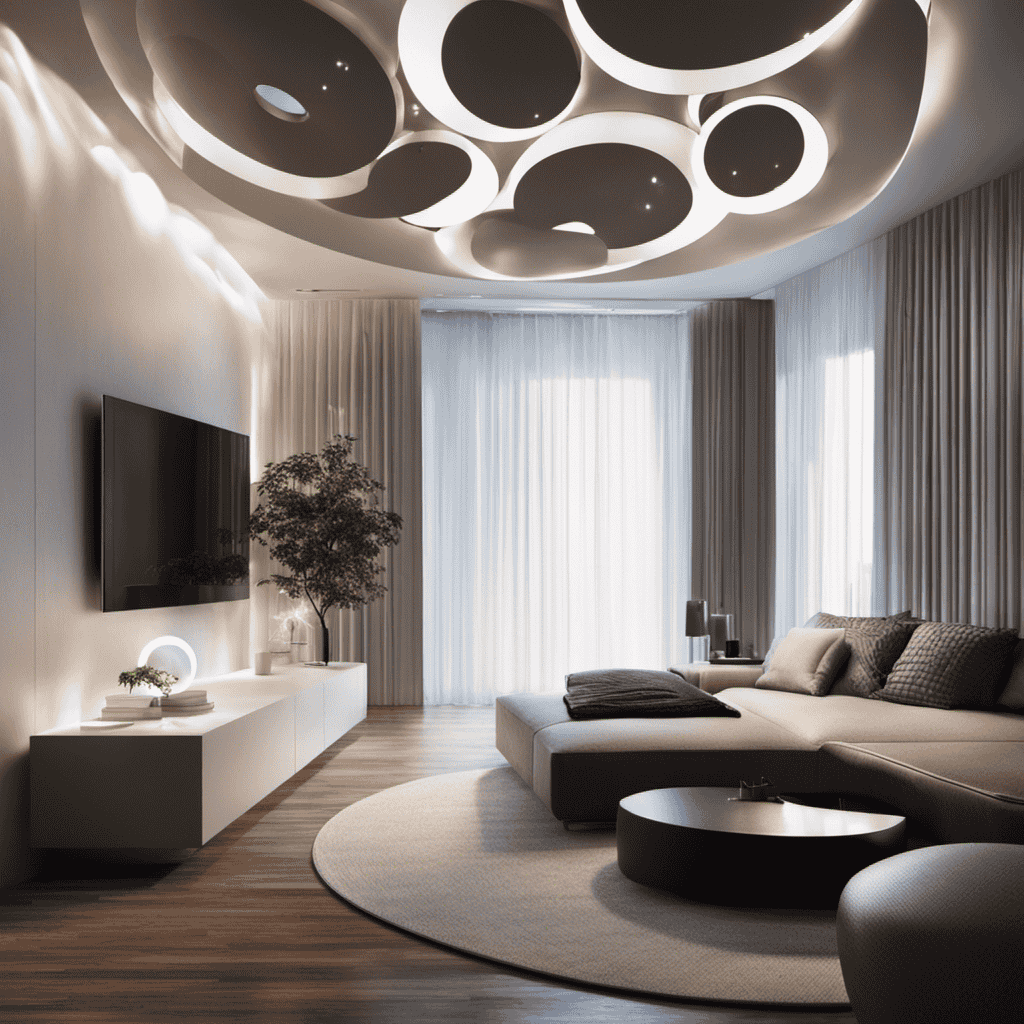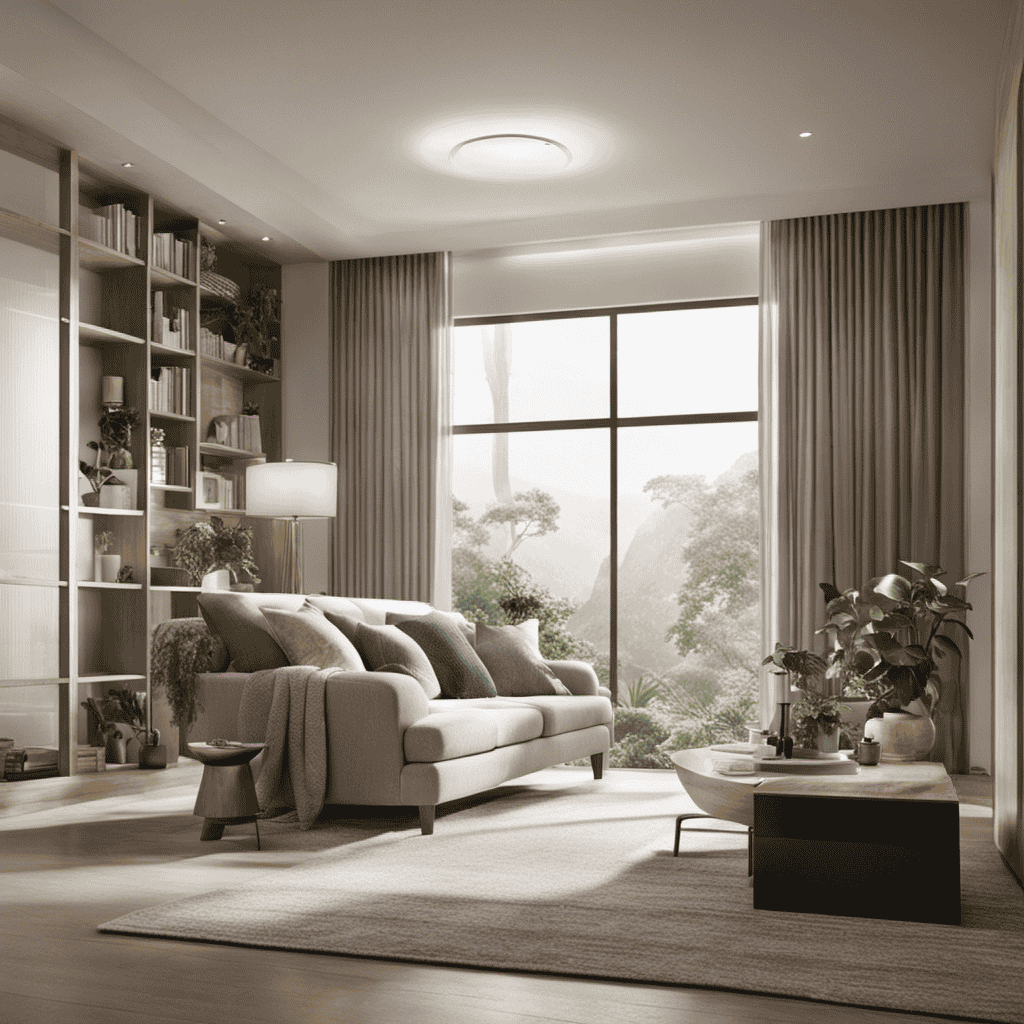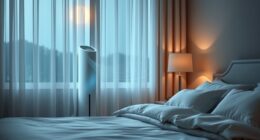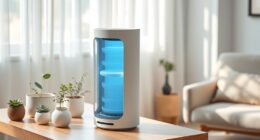As a homeowner, it is important to me that the air I breathe is clean and free from pollutants. This is why it is crucial to understand how frequently an air purifier should be running.
In this article, we will explore the factors to consider when determining air purifier runtime, the recommended run times based on room size, and the impact of air quality levels on runtime.
By the end, you’ll have a clear understanding of how to optimize the use of your air purifier for maximum allergen control and a healthier living environment.
Key Takeaways
- The recommended runtime of an air purifier depends on factors such as the room size and the specific model of the purifier.
- Air quality levels and the impact of air pollution on health should be considered when determining how often an air purifier should run.
- The lifespan and performance of air purifier filters play a crucial role in deciding the runtime and maintenance schedule of the purifier.
- Regularly cleaning and replacing filters, as well as using power-saving settings, can help decrease energy consumption and ensure efficient operation of the air purifier.
Factors to Consider When Determining Air Purifier Runtime
When deciding how often to run an air purifier, there are several factors that should be considered.
One important factor is the recommended maintenance for your specific air purifier model. Most manufacturers provide guidelines on how often filters should be changed or cleaned. Following these recommendations ensures that your air purifier is functioning optimally and effectively removing pollutants from the air.
Another factor to consider is the air purifier lifespan. Like any appliance, air purifiers have a limited lifespan, and running them continuously can decrease their longevity. It is important to balance the need for clean air with the longevity of your air purifier.
By understanding the recommended maintenance and lifespan of your air purifier, you can determine an appropriate runtime that maximizes its efficiency while prolonging its lifespan.
Now, let’s explore recommended run times based on room size.
Recommended Run Times Based on Room Size
To determine the recommended run times for an air purifier based on the size of your room, you can consult the manufacturer’s guidelines or refer to online resources. These sources provide valuable information on the ideal runtime for different room sizes, taking into account air purifier efficiency. Here is a table that summarizes the recommended run times based on room size:
| Room Size | Recommended Run Time |
|---|---|
| Small | 4-8 hours |
| Medium | 8-12 hours |
| Large | 12-16 hours |
| Extra Large | 16-24 hours |
These run times ensure optimal air purification while maximizing energy efficiency. It is important to note that these guidelines are general recommendations, and factors such as air quality levels and specific purifier models may influence the ideal runtime. Understanding air quality levels and their impact on runtime will be discussed in the next section.
Understanding Air Quality Levels and Their Impact on Runtime
Understanding how air quality levels can impact the runtime of your air purifier is crucial for ensuring that you achieve the best possible purification results for your room. Air pollution effects can vary depending on the location and the specific pollutants present, but it is well known that exposure to poor air quality can have detrimental effects on our health.
By running your air purifier for an appropriate amount of time, you can effectively reduce the levels of harmful pollutants in your indoor environment, leading to significant health benefits. Monitoring the air quality in your room using a dedicated air quality monitor can help you determine the ideal runtime for allergen control.
With this information, you can make informed decisions about when to run your air purifier and for how long to ensure optimal purification and protection against air pollution.
How to Determine the Ideal Runtime for Allergen Control
Using a dedicated air quality monitor can help you determine the ideal runtime for controlling allergens in your room. By analyzing real-time data, you can effectively assess the effectiveness of your air purifier and make informed decisions about its runtime.
Here are five factors to consider when determining the ideal runtime for allergen control:
-
Air purifier placement: The location of your air purifier can significantly impact its performance. Placing it in an area with high pollutant concentration, such as near a window or in the center of the room, can maximize its effectiveness.
-
Room size: The square footage of your room plays a crucial role in determining the runtime. A larger room may require a longer runtime to achieve optimal air quality.
-
Outdoor air quality: Monitoring the air quality outside can help you gauge the amount of pollutants entering your room and adjust the runtime accordingly.
-
Sensitivity to allergens: People with allergies may require longer runtimes to maintain clean air and reduce symptoms.
-
Time of day: Air quality can fluctuate throughout the day, so adjusting the runtime based on peak pollution periods can be beneficial.
Considering these factors will enable you to determine the most effective runtime for allergen control in your room.
Transitioning into the subsequent section, let’s explore the role of air purifier filters in making informed runtime decisions.
The Role of Air Purifier Filters in Runtime Decision-making
When considering the ideal runtime for an air purifier, two key factors to consider are the lifespan and performance of the filters, as well as the impact on energy consumption.
The lifespan of the filters directly affects the maintenance schedule and costs associated with replacing them. Additionally, the performance of the filters determines their effectiveness in removing allergens and pollutants from the air.
Both of these factors play a significant role in determining the optimal runtime for an air purifier, as they directly impact its overall efficiency and effectiveness.
Filter Lifespan and Performance
To maximize the lifespan and performance of your air purifier’s filter, you should regularly check and replace it according to the manufacturer’s guidelines. Here are some maintenance tips for filter replacement:
- Inspect the filter regularly for any signs of wear or damage.
- Clean the filter as recommended by the manufacturer to remove accumulated dust and debris.
- Replace the filter at the recommended intervals to ensure optimal filtration efficiency.
- Consider using high-quality filters that are specifically designed for your air purifier model.
- Keep track of the filter’s usage and replace it promptly when it reaches its maximum lifespan.
Impact on Energy Consumption
Regularly cleaning and replacing your air purifier’s filter can help decrease its energy consumption. The filter is an essential component that traps airborne particles and pollutants, ensuring clean and fresh air.
Over time, the filter becomes clogged with dirt and debris, forcing the air purifier to work harder to maintain optimal performance. This increased workload leads to higher energy consumption. By cleaning or replacing the filter according to the manufacturer’s recommendations, you can ensure that your air purifier operates efficiently, using less power to achieve the same air quality.
Additionally, some air purifiers come with power-saving settings that further reduce energy consumption without compromising performance. Considering the impact on air purifier lifespan, maintaining the filter regularly not only helps save energy but also ensures the longevity of the device.
Now, let’s delve into energy efficiency considerations for air purifier usage.
Energy Efficiency Considerations for Air Purifier Usage
When it comes to energy efficiency considerations for air purifier usage, there are a few key points to keep in mind.
First, determining the optimal run time is crucial to strike a balance between maintaining clean air and conserving energy.
Second, conducting a power consumption analysis will help identify any energy-hungry features or settings that can be adjusted to reduce electricity usage.
Lastly, exploring eco-friendly operating modes, such as sleep or low power mode, can further minimize power consumption and contribute to a more sustainable and environmentally friendly air purifier usage.
Optimal Run Time
The optimal run time for an air purifier is typically around 8 to 12 hours per day. This recommended duration ensures that the air in your home or office space remains clean and healthy.
Here are some health benefits of running an air purifier for the recommended duration:
- Reduction of airborne allergens such as pollen, dust mites, and pet dander, which can cause allergies and respiratory issues.
- Elimination of harmful pollutants like smoke, odors, and volatile organic compounds (VOCs), promoting a cleaner breathing environment.
- Prevention of respiratory infections by removing bacteria and viruses from the air.
- Improvement in sleep quality, as the purified air helps to alleviate symptoms of asthma and snoring.
- Enhancement of overall well-being by creating a fresh and pleasant indoor atmosphere.
Power Consumption Analysis
Running an air purifier for the recommended duration can help you save on power consumption. It’s important to analyze the power usage of your air purifier to understand its impact on your electricity bill. A cost analysis can provide valuable insights into the energy efficiency of your device.
Most air purifiers have different power settings, such as low, medium, and high. By running the air purifier on a lower setting, you can reduce power usage and save money in the long run. Additionally, some air purifiers come with advanced features like automatic sensors that adjust the fan speed based on the air quality. These eco-friendly operating modes not only help in reducing power consumption but also ensure efficient air purification.
Transitioning into the next section, let’s explore these eco-friendly operating modes in more detail.
Eco-Friendly Operating Modes
Using the eco-friendly operating modes on your air purifier can help reduce power consumption and ensure efficient air purification. Here are some features to consider for eco-friendly operation and sustainable air purification:
-
Smart Sensor Technology: This feature detects the air quality in real-time and adjusts the purifier’s settings accordingly, optimizing energy usage.
-
Sleep Mode: Designed for nighttime use, this mode operates at a lower fan speed and dims the display to minimize disturbance and save power.
-
Timer Function: Set a specific operating time for your air purifier to ensure it runs only when needed, minimizing unnecessary energy consumption.
-
Energy Star Certification: Look for air purifiers with the Energy Star label, as they meet strict energy efficiency guidelines, reducing both power usage and environmental impact.
-
Filter Replacement Indicator: A helpful feature that alerts you when it’s time to replace the filter, ensuring optimal performance and preventing energy wastage.
Addressing Odor Issues: How Long Should an Air Purifier Run
To effectively address odor issues, it’s important to consider how long an air purifier should be running. The ideal duration for running an air purifier depends on several factors, including the size of the room, the level of odor, and the type of air purifier being used. A general guideline is to run the air purifier for at least 6-8 hours a day to effectively control odors. However, in cases of strong or persistent odors, it may be necessary to run the air purifier continuously. I have created a table below to provide a visual representation of the recommended duration based on room size and odor intensity.
| Room Size | Mild Odor (6-8 hours) | Strong Odor (24 hours) |
|---|---|---|
| Small (<150 sq ft) | 6-8 hours | 24 hours |
| Medium (150-300 sq ft) | 6-8 hours | 24 hours |
| Large (>300 sq ft) | 6-8 hours | 24 hours |
Balancing Noise Levels and Air Purifier Runtime
When it comes to achieving optimal purifier runtime, it is crucial to strike a balance between noise levels and air purification efficiency. Noisy air purifiers can disrupt sleep and cause annoyance, while running the purifier for extended periods can result in unnecessary energy consumption.
Therefore, implementing noise reduction strategies can help create a more comfortable environment without compromising the purifier’s effectiveness.
Optimal Purifier Runtime
The optimal runtime for an air purifier depends on factors such as room size and air quality. To maintain air purifier efficiency, it is essential to find the right balance of runtime frequency.
Here are some key points to consider:
- Room size: Larger rooms may require more runtime to effectively purify the air.
- Air quality: If the air quality is poor, the air purifier may need to run for longer periods to remove pollutants.
- Allergies: Individuals with allergies may benefit from running the purifier more frequently, especially during peak allergy seasons.
- Pets: If you have pets, their dander and hair can circulate in the air, necessitating longer runtime for consistent purification.
- Smoking: If you or someone in your household smokes, it is advisable to run the purifier continuously to eliminate smoke particles.
Noise Reduction Strategies
Consider adjusting the fan speed and placing the air purifier away from walls or furniture to reduce noise. When it comes to noise reduction techniques for air purifiers, these simple adjustments can make a significant difference in creating a quieter environment. Additionally, selecting the right air purifier model can also contribute to noise reduction. Look for purifiers with noise reduction features such as quiet mode or sleep mode, which operate at a lower fan speed to minimize noise levels. To help you in selecting the right model, here is a table outlining noise levels (in decibels) for different air purifiers:
| Air Purifier Model | Noise Level (dB) |
|---|---|
| Model A | 35 |
| Model B | 40 |
| Model C | 45 |
| Model D | 50 |
| Model E | 55 |
Seasonal Variations in Air Purifier Usage
There’s a difference in how often you should run an air purifier depending on the season. Proper air purifier maintenance is crucial for its cost-effective operation. Here are some guidelines to help you optimize your air purifier usage throughout the year:
-
Spring: As pollen counts rise, run the air purifier continuously to remove allergens from the air.
-
Summer: With increased humidity, run the air purifier to combat mold and mildew growth.
-
Fall: As leaves and outdoor debris make their way inside, keep the air purifier running to capture particles.
-
Winter: While indoor air quality tends to be better in winter, running the air purifier intermittently can help remove dust and pet dander.
Long-Term Effects of Continuous Air Purifier Operation
To avoid potential health risks, it’s important to be mindful of the long-term effects of continuously operating an air purifier. While air purifiers are designed to improve indoor air quality, excessive use can have negative consequences on our health. Continuous operation can lead to dryness and irritation of the respiratory system, especially if the air purifier is not properly maintained. Regular maintenance, such as cleaning or replacing filters, is crucial to ensure optimal performance and prevent the buildup of pollutants. Neglecting air purifier maintenance can result in decreased efficiency and increased exposure to harmful particles. It’s recommended to refer to the manufacturer’s guidelines for specific maintenance instructions. By being aware of the long-term health effects and prioritizing regular maintenance, we can maximize the benefits of using an air purifier while minimizing any potential risks.
| Issue | Long-Term Health Effects | Air Purifier Maintenance |
|---|---|---|
| Dryness and Irritation of Respiratory System | ✔️ | ✖️ |
| Decreased Efficiency | ✔️ | ✔️ |
| Increased Exposure to Harmful Particles | ✔️ | ✔️ |
Frequently Asked Questions
Can I Leave My Air Purifier Running All Day and Night?
Yes, you can leave your air purifier running all day and night. However, keep in mind that it will consume energy continuously. It’s important to consider the energy consumption and adjust the usage accordingly.
How Often Should I Replace the Filters in My Air Purifier?
Replacing air purifier filters depends on usage and air quality. Generally, it’s recommended to replace them every 3-6 months. To maximize efficiency, clean the exterior regularly. Benefits of using an air purifier in a small office space include improved air quality and reduced allergens.
Can an Air Purifier Help Reduce Humidity Levels in a Room?
An air purifier can help reduce humidity levels in a room by filtering out excess moisture. It is especially effective for people with allergies or those who need to remove smoke particles from the air.
Are There Any Health Risks Associated With Running an Air Purifier for Long Periods of Time?
Running an air purifier for long periods of time may pose some health risks. However, when used appropriately, air purifiers can provide numerous health benefits. It is important to balance the benefits with energy consumption.
Can an Air Purifier Remove Pet Dander and Pet Odors From the Air?
Yes, an air purifier can effectively remove pet dander and pet odors from the air. Regular maintenance of the air purifier ensures optimal performance and maximizes the benefits of using it.
Conclusion
Determining the ideal runtime for an air purifier is crucial, as it involves analyzing factors like room size, air quality levels, and allergen control. The role of air purifier filters is also important, as they play a vital role in maintaining clean and healthy air. Addressing odor issues and balancing noise levels can help achieve the right runtime. It is also essential to consider seasonal variations in air purifier usage. Ultimately, continuous operation of an air purifier can have long-term positive effects on indoor air quality. So, set your purifier to purr for pristine air!
